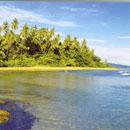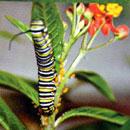Costa Rica: A Legit Natural Paradise
Costa Rica lies in the tropics between 8 and 11 degrees north of the equator. You might expect moderate temperatures, but the rugged mountain chain's effect on factors such as wind, and rain, create many microclimates. Most people are surprised to learn that frost and ice can occur on some of the loftier peaks, such as Chirripo. Temperatures are somewhat higher on the Pacific side than on the Caribbean at the same elevation because there are more clouds on the Caribbean watershed year-round than on the Pacific. At sea level on either side, the annual average is always above 75°F (24°C).
Some of the highest peaks average 54°F (12°C), though temperatures there can fall below freezing. There is not spring, or fall times in Costa Rica. The seasons are called summer and winter. They are just a dry season (since December until April) and a rainy season (since May until November). Temperature has more variation from night to day than from summer to winter. Difference in daily temperatures averages 14°F to 18°F (8°C to 10°C). From November to January, cold breezes from the north funnel through the mountains of North America causing a little down in temperature. This is one of the few countries in the world in which polar air gets this close to the equator. The warmest months are March, April, and May, and the wettest months are September and October. Rainfall amounts vary from less than 59 inches (1,500mm) to more than 190 inches (4,800mm) during these months. The country's average rainfall pattern is in the range of 79 to 158 inches (2,000 to 4,000 mm). Precipitation can come in the form of a tropical downpour with impressive lightning and thunder, steady rain, or the less common, a continuous light rain for several days.
Even in the rainy season, rain will not fall during the all day, every day. It usually begins in early afternoon in the Central Valley and other highland areas, but later in the afternoon in the Pacific lowlands. Each season has its own beauty and unique characteristics.
SAN JOSE: A City of Contrasts The Costa Rican capital is the heart and soul of the country. It harbors all government offices and it's the financial and economic hub. More than half of the population lives there. Modern and intimate, and with a perfect weather, many foreigners have picked this city to settle down. Travelers get pleasantly surprised with contrasts in a burg that features glamorous skyscrapers and classical buildings. San Jose is a perfect city for taking a walk around, melting unworriedly into the local population since early in the morning.
You can also head for the headquarters of the Costa Rican Tourism Institute where nice clerks will provide you with all the information and maps you might need. They'll also give useful tips for your bus rides and hikes around town, to both near and far sightseeing places. And don't forget to drop by the Cathedral, in the downtown area, nor the National Theater, the National Museum, the Museum of Gold and the Museum of Entomology. All of them treasure valuable collections dealing with Costa Rica's historic, religious, archeological, artistic and natural heritage.
A Natural Sanctuary Even though Costa Rica is a small country, it has a great biological and habitat diversity due to the convergence of two hemispheres, two oceans, and its varying geography. This creates wonderful changing views for travelers. There is a chain of mountains that forms a back- bone down the length of Costa Rica. They start in the north with the Guanacaste "Cordillera" (mountain range), continues with the Tilaran Cordillera (location of Monteverde and Arenal), the Central Cordillera (Irazu, Poas, Braulio Carrillo), and finishes with the southern Talamanca Cordillera (which is the highest in the country). While the Pacific coastline is almost 780 miles (1,254 km), the Caribbean is only 132 miles (212 km).
Hilly peninsulas are settled in the Pacific coast. There are two large gulfs, and many small coves and bays. Two major commercial ports are located in the Pacific: Puntarenas and Puerto Caldera. On the Caribbean, there is a natural harbor in the Moin - Limon area. It is the largest area of lowland plains (about one-fifth of Costa Rica), which stretches back from the northern coastline almost to Limon.
Unforgettable Places Feel the ground tremble and see the night sky explode with ash and lava in a natural display of fireworks. Arenal Volcano National Park is part of the Area de Conservacion Arenal, which protects most of the Cordillera de Tilaran. It contains half the species of land welling vertebrates ( birds, mammals, reptiles, and amphibians ) known in Costa Rica. The Arenal volcano was temporarily dormant form about 1500 AD until July 29, 1998, when huge explosions triggered lava flows that destroyed two villages.
The 54,539-hectare Corcovado National Park has astonishing biological diversity that attracts the attention of ecologists who study the intricate rainforest. The park was established in 1975, and has two sections. Most of it is in the southwestern corner of the Peninsula de Osa and protects at least eight distinct types of habitat.
This assemblage is considered unique, being the best remaining Pacific Coastal Rainforest in Central America. Later, 12751 hectares were added on the northeastern side of the Golfo Dulce. Many important species are protected here: the beautiful scarlet macaw, tapirs, wild cats, crocodiles, peccaries, giant anteaters, monkeys, sloth, the rare harpy eagle, almost 400 species of birds, 140 mammals and over 500 species of trees. These beaches are facing the tropical dry forest -located around 296 Km. northeast from San José, 5 hours by car-. The marine life of these places is abundant: manta rays with 4 to 6m fin spans, other rays, huge schools of fish, and plenty of coral reef life among others.
The Southern Caribbean shows impressive cultural diversity where blacks, indigenous, and Europeans have created a very relaxed way of living. For instance, you are able to buy Bribri handicrafts, eat delicious Italian food, listen to reggae and calypso music, and talk to the old timers. You will discover this friendly and easy environment. Towns and beaches: Cahuita, Puerto Vargas, Pirikiki Beach, Chiquita Beach, Cocles Beach, Uva Beach, and Manzanillo Beach. Activities you may perform: diving, surfing, hiking, sport fishing, dolphin tour, tour to Kekoldi Native Reserves, horseback riding, bird watching, and more.
On Tamarindo Beach, you will have more than 2 Km of the most beautiful beaches in Costa Rica under your feet. Just north of Tamarindo village, you will find Las Baulas de Guanacaste Marine National Park that was created in 1991 and covers about 22,000 hectares of ocean and 420 hectares of land. Most of its land contains all six of the mangrove species found in Costa Rica: two species of black mangrove, tea, white, red, and buttonwood. This creates a great habitat for bird species including the beautiful roseate spoonbill as well as for caimans and crocodiles.
Carara Biological Reserve is at the mouth of Río Tárcoles, around 50 km southeast of Puntarenas by road. It has 4,700 hectares, and it is the northern most tropical wet forest on the Pacific coast, in the transition zone to the tropical dry forest farther north, and five Holdridge Life Zones occur within the park. Some animals to see: scarlet macaws, iguanas, trogons, toucans, marmots, monkeys, squirrels, sloth, and agoutis among others. The average temperature is 27° C/80°F. , and the rainfall is almost 3000mm annually. Activities to do in the area: golfing, sport fishing, scuba diving, ocean kayaks, surfing, windsurfing, jet skis, body boards, snorkeling, boat charters to various destinations available, tour to Tortuga Island, wildlife watching, bike rental, and horseback riding among others. The Flavors of Tradition When it comes to food, mealtime in Costa Rica is sacred and part of a rich familiar tradition, usually marked by long after-dinner talks. What local resident put on their tables ranges from rice and beans to bread, tortillas and fruits. Gallo pinto –a mixture of rice and peas- is the commonest breakfast treat in Costa Rica. Casado is the dish of choice at lunch, based on rice, peas, eggs, meat and bananas. Olla de carne is a popular stew made of ox and potatoes, onion and vegetables. During Easter and Christmas festivities, most people prefer tamales and meat empanadas, vegetables and oatmeal wrapped in banana leaves. Other top choices are lengua en salsa, mondongo, empanadas, rice and chicken, and gallos (tortillas stuffed with meat and vegetables). Every dinner comes to a close with a cup of piping-hot coffee, one of the country's main crops.




































































